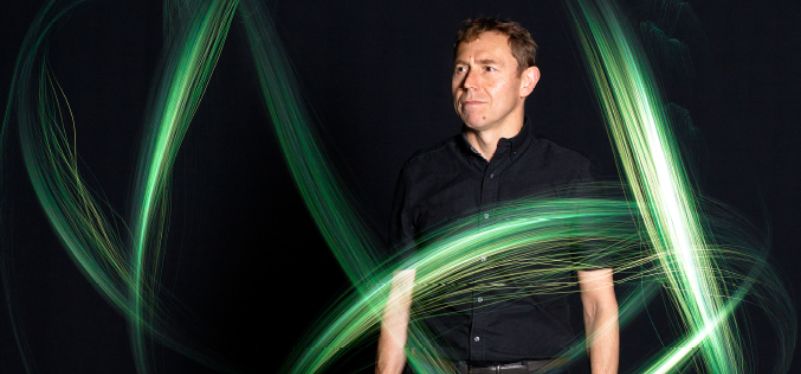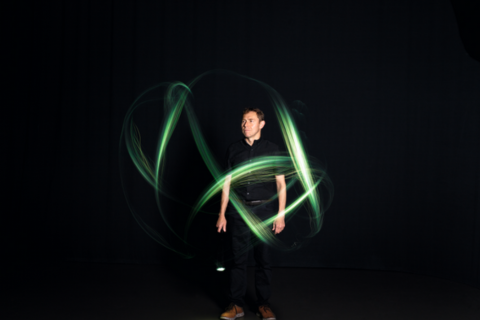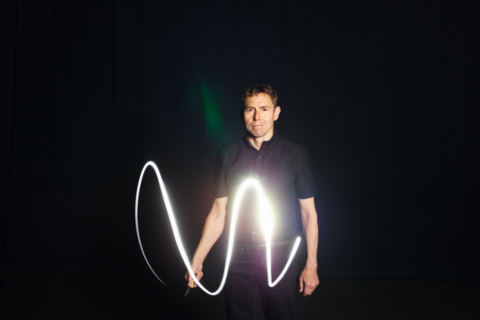Moving at the speed of light
In 2017, Professor Stephen Smartt tracked a ripple in space. What happened next changed the world

It’s 17 August 2017. Professor Stephen Smartt – keen marathon runner, triathlete and Professor of Astrophysics – has just returned from a lunchtime run. Sweaty, out of breath, Smartt goes to check his email. The alert he receives sets his pulse racing even more.
The message? A collaboration of gravitational wave observatories in the USA and Italy have detected a signal – a ripple in space and time, travelling at the speed of light. This in itself isn’t the exciting part – after all, gravitational waves had been observed a couple of years earlier, proving Einstein’s general theory of relativity and winning the scientists involved the Nobel Prize in Physics. But it means that there is now a small window of opportunity to identify the source, something that has never been done. Scientists around the world leap into action: the race is on.
“I thought, ‘Woah, this could be it!’,” recalls Smartt. “Everyone around the world was thinking, can we find the source? When stars merge and emit gravitational waves, the game is to find them as quickly as possible so that we don’t lose out on early, critical data within the first few hours.”
Gravitational wave detectors are deployed across the globe but, as Smartt explains, they can’t pinpoint exactly where waves come from, just help to narrow down the search. “In this case, it was an area just above the horizon around about 130 million light-years away. It’s our job to point our telescopes in the right direction – it can be a big chunk of sky, but there can only be one thing that’s emitted the gravitational waves. We rule things out. We survey that sky for anything that wasn’t there before but has popped up since the gravitational wave detection.
The gravitational wave signal is exquisitely timed but poorly localised.”Just 11 hours after getting the alert from the observatories, a number of Chilean telescopes seemed to be leading the race, identifying a likely candidate for the source: a tiny point of light in a galaxy called NGC 4993. But it wasn’t until 24 hours later that one team, led by Smartt, took the first definitive spectrum – a graph showing the intensity of light being emitted – of the object.
“I stayed up all night to work with our team on site in Chile and to see the spectrum that came through,” Smartt remembers. “As soon as I looked at it, I knew we’d got it. It was truly groundbreaking and a triumph for a very talented group of theoretical astrophysicists who had predicted how this event would emit light."
SCIENCE FICTION
It could all have been so different. Smartt only became interested in space in his final year at Queen’s. As a child he loved science and science fiction but “never thought of it as a career”, he says. He didn’t even own a telescope. Having done well in maths and physics at school, an electrical engineering degree seemed like a good fit. Within a few months of starting at Queen’s, however, he knew he’d made a mistake: “I wanted to do something more fundamental than engineering,” he says.

So he completed his first year in electrical engineering, then transferred to physics and applied mathematics. He heard about a summer placement with what was then the Astrophysics and Planetary Sciences Division at Queen’s – popularly known as the ‘Space Group’ – and decided to apply. “I didn’t really know what the project was but I thought it sounded interesting: something to do with stars,” he says. Smartt wasn’t set on astrophysics at that stage – a summer placement in particle physics based at CERN (now home to the world’s largest particle accelerator) had also caught his eye. “I didn’t get it,” he says. “But I did get the one in astrophysics. So that was it.”
Particle physics’ loss was astrophysics’ gain. Smartt began a doctorate in the chemical make-up of massive stars (typically defined as those with a mass 10 times larger than that of our Sun) in our galaxy, the Milky Way. He was awarded his PhD in Astrophysics from Queen’s in 1996 and has never looked back. He spent three years as a staff astronomer at the Isaac Newton Group of Telescopes on La Palma in the Canary Islands before taking up a postdoctoral position followed by a fellowship at the University of Cambridge, and then returned to Queen’s.
Since then, Smartt and the groups he has led have made a series of significant discoveries relating to stellar evolution (the process by which a star changes over the course of time), supernovae (the most powerful stellar explosions) and the source of gravitational waves.
Throughout all these years studying the goings-on of the night sky, however, it’s always been the physics that’s guided him, rather than any romantic notions about the majesty of space. “Some people think we sit and look through telescopes and wonder what that is, but in reality it’s all basic physics and mathematics and computer programming,” he says.
MOVES AND FLASHES
In fact, Smartt rarely looks through telescopes. Nonetheless, telescopes are critical to his work, which relies on enormous quantities of data gathered by telescopes all over the world, from Hawaii to South Africa and from Chile to the Canary Islands. These large sky survey projects – known as time-domain sky surveys – allow Smartt and his team to keep track of anything new that appears at any time, not just because they’re always working, but also because between them they cover the entire sky.

The telescopes are fitted with detectors capable of making very detailed physical measurements – the number of photons being detected from a particular object, for example, or the number of photons of a particular wavelength – which are then processed immediately by Smartt and his colleagues with a view to identifying unusual activity.
“We find everything that either moves or flashes and then get ready to do the same thing the next night,” he says. Mergers of small objects like neutron stars, which might only be around 10km across, might flash and disappear in just a few days. Then there are superluminous supernovae produced by the explosion of objects perhaps 40 times the mass of our Sun, that go on for many months because it takes time for the energy in them to radiate away. “Having identified moving and flashing objects, the task is then to find a model to explain why we detect that energy,” says Smartt. “We need a physical theory to explain exactly what we are measuring.”
As well as working on the data themselves, Smartt’s group makes it publicly available so that other scientists can search for objects in the sky. “If anyone finds anything that they think is interesting, they can go back and, weather permitting, they’re guaranteed an image of that bit of sky from our surveys,” explains Smartt.
They do this partly because they have to: four of the telescopes gathering data for the Queen’s group were developed as an asteroid impact early warning system funded by NASA; they’re there primarily to enable scientists around the world to identify asteroids and thereby give advance warning to communities that might be affected by an asteroid strike. But Smartt would release the data even if it wasn’t required. “Sometimes you might want to work on the data yourself but competition is a good thing,” he says. “There’s certainly too much data for us to exploit ourselves.”
As well as being awarded a CBE for services to science, Smartt’s work on the gravitational waves, along with his pioneering use of digital sky surveying, led to him being elected as a Fellow of the Royal Society in 2020. In a career full of honours, this is the most significant as far as he is concerned. “I’ll never forget those eight incredible weeks in 2017, but election to the Royal Society is the thing I’m most proud of. It’s recognition from your peers that you have achieved at quite a high scientific level,” he says with typical modesty. “I was very happy with that.”